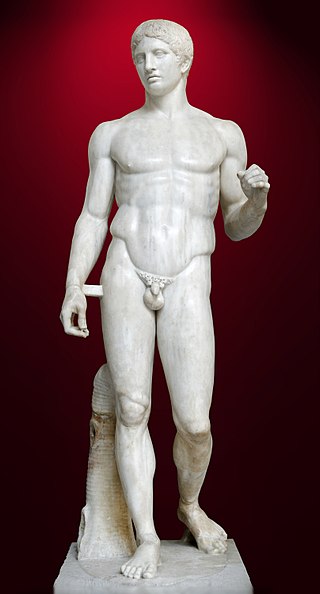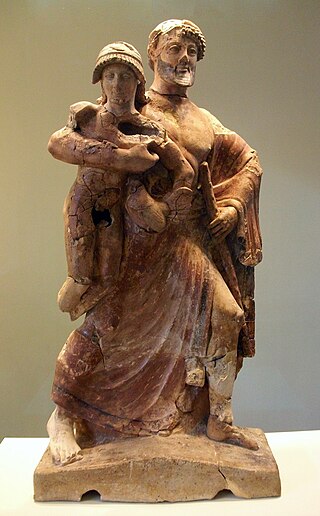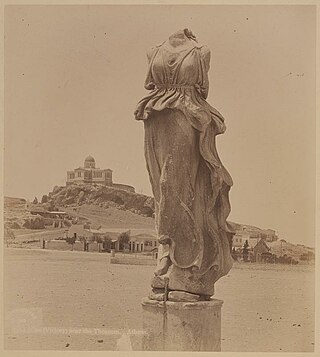

The Nike of Paros is an early classical depiction of Nike from the 5th century BC (c. 480 BC). The white marble figure was found before 1885 on the island of Paros. It is currently on display at the Archaeological Museum of Paros. [1]


The Nike of Paros is an early classical depiction of Nike from the 5th century BC (c. 480 BC). The white marble figure was found before 1885 on the island of Paros. It is currently on display at the Archaeological Museum of Paros. [1]
The female figure, originally winged, was depicted floating in mid-air, in an unbelted peplos which hung open. The wings and this posture identify her as Nike.
The head, left arm, lower right arm, most of the wings and the feet are missing. Even so, it can be recognised that the left leg is slightly further forward, while the right leg seems to have been pulled back. This posture in connection with the forward lean of the figure as a whole is also a characteristic posture in later depictions of Nike like the Nike of Paionos. In the classical period this posture replaced the archaic "kneeling run" as the usual way of depicting Nike. The forward slope of the body's axis, which is created mainly by the straightness of the upper body and the strong incline of the lower body to the left, would have made the whole figure tilt slightly and would have shifted all weight off the left leg. The left arm must be reconstructed as having stretched upwards, when the figure was fixed in place. It is the resulting disregard for the rules of gravity which gave the Nike of Paros the appearance of floating. A transition takes place then in statuary from a sideways to a forward moving figure, as a result of the change in pose.
The original circumstances of this Nike's creation are not clearly known. Either she served as an acroterion or she must have been a victory monument. Although no Parian victory is known to have occurred around 470/60 BC, the fact that it is carved all the way round makes it more likely that it was a victory monument. [2]

Polykleitos was an ancient Greek sculptor, active in the 5th century BCE. Alongside the Athenian sculptors Pheidias, Myron and Praxiteles, he is considered as one of the most important sculptors of classical antiquity. The 4th century BCE catalogue attributed to Xenocrates, which was Pliny's guide in matters of art, ranked him between Pheidias and Myron. He is particularly known for his lost treatise, the Canon of Polykleitos, which set out his mathematical basis of an idealised male body shape.

The Winged Victory of Samothrace, or the Nike of Samothrace, is a votive monument originally found on the island of Samothrace, north of the Aegean Sea. It is a masterpiece of Greek sculpture from the Hellenistic era, dating from the beginning of the 2nd century BC. It is composed of a statue representing the goddess Niké (Victory), whose head and arms are missing and its base is in the shape of a ship's bow.

The Temple of Athena Nike is a temple on the Acropolis of Athens, dedicated to the goddesses Athena and Nike. Built around 420 BC, the temple is the earliest fully Ionic temple on the Acropolis. It has a prominent position on a steep bastion at the south west corner of the Acropolis to the right of the entrance, the Propylaea. In contrast to the Acropolis proper, a walled sanctuary entered through the Propylaea, the Victory Sanctuary was open, entered from the Propylaea's southwest wing and from a narrow stair on the north. The sheer walls of its bastion were protected on the north, west, and south by the Nike Parapet, named for its frieze of Nikai celebrating victory and sacrificing to their patroness, Athena and Nike.

The Charioteer of Delphi, also known as Heniokhos, is a statue surviving from Ancient Greece, and an example of ancient bronze sculpture. The life-size (1.8m) statue of a chariot driver was found in 1896 at the Sanctuary of Apollo in Delphi. It is now in the Delphi Archaeological Museum.

Scopas was an ancient Greek sculptor and architect, most famous for his statue of Meleager, the copper statue of Aphrodite, and the head of goddess Hygieia, daughter of Asclepius.

The Doryphoros of Polykleitos is one of the best known Greek sculptures of Classical antiquity, depicting a solidly built, muscular, standing warrior, originally bearing a spear balanced on his left shoulder. Rendered somewhat above life-size, the lost bronze original of the work would have been cast circa 440 BC, but it is today known only from later marble copies. The work nonetheless forms an important early example of both Classical Greek contrapposto and classical realism; as such, the iconic Doryphoros proved highly influential elsewhere in ancient art.

Classical sculpture refers generally to sculpture from Ancient Greece and Ancient Rome, as well as the Hellenized and Romanized civilizations under their rule or influence, from about 500 BC to around 200 AD. It may also refer more precisely a period within Ancient Greek sculpture from around 500 BC to the onset of the Hellenistic style around 323 BC, in this case usually given a capital "C". The term "classical" is also widely used for a stylistic tendency in later sculpture, not restricted to works in a Neoclassical or classical style.

The Augustus of Prima Porta is a full-length portrait statue of Augustus Caesar, the first emperor of the Roman Empire.

The Temple of Ares was a Doric hexastyle peripteral temple dedicated to Ares, located in the northern part of the Ancient Agora of Athens. Fragments from the temple found throughout the Agora enable a full, if tentative, reconstruction of the temple's appearance and sculptural programme. The temple had a large altar to the east and was surrounded by statues. A terrace to the north looked down on the Panathenaic Way. The northwest corner of the temple overlays one of the best-preserved Mycenaean tombs in the Agora, which was in use from ca. 1450-1000 BC.

In Greek mythology and ancient religion, Nike; Ancient Greek: Νίκη, romanized: Nike, lit. 'victory'; pronounced[nǐː.kɛː], modern: ) is the goddess who personifies victory in any field including art, music, war, and athletics. She is often portrayed in Greek art as Winged Victory in the motion of flight; however, she can also appear without wings as "Wingless Victory" when she is being portrayed as an attribute of another deity such as Athena.

The Group of Zeus and Ganymede is a multi-figure Late Archaic Greek terracotta statue group, depicting Zeus carrying the boy Ganymede off to Mount Olympus. It was created in the first quarter of the fifth century BC and is now displayed near where it was originally found in the Archaeological Museum of Olympia.
The Peplos Kore is an ancient sculpture from the Acropolis of Athens. It is considered one of the most well-known examples of Archaic Greek art. Kore is a type of archaic Greek statue that portray a young woman with a stiff posture looking straight forward. Although this statue is one of the most famous examples of a kore, it is actually not considered a typical one. The statue is not completely straight, her face is leaned slightly to the side, and she is standing with her weight shifted to one leg. The other part of the statues name, peplos, is based on the popular archaic Greek gown for women. When the statue was found it was initially thought that she was wearing a peplos, although it is now known that she is not.

An Attic funerary relief, sometimes also known as the Mithridates funerary relief is displayed at the National Archaeological Museum of Athens (NAMA), with the inventory number 4464. Its date is uncertain.

The Nike of Callimachus also known as The Dedication of Callimachus, is a statue that the Athenians created in honour of Callimachus.

The Nike of Paionios is an ancient statue of the Greek goddess of victory, Nike, made by sculptor Paionios between 425 BC and 420 BC. Made of Parian marble, the medium gives the statue a translucent and pure white look to it. Found in pieces, the statue was restored from many fragments but is lacking face, neck, forearms, part of left leg, toes, and some fragments of drapery. It also had wings. The goddess is shown landing gently on her left foot, with the drapery blown against her body.

The Tübingen Hoplitodromos Runner is a statuette of an Ancient Greek athlete wearing a helmet, made in Attica around 485 BC. It is exhibited in the Museum Alte Kulturen of the University of Tübingen. At the end of the 19th century, the characteristic posture of the athlete led Friedrich Hauser to interpret the statuette as an armed hoplitodromos runner in the starting position, an interpretation that is undisputed today.

The Athena Marsyas Group was a bronze sculptural group by Myron that stood on the Acropolis of Athens in the high classical period, dated to c 450 BCE. Now lost, it has been reconstructed from copies, coins, other visual sources and literary testimonia. The work depicted the satyr Marsyas picking up an aulos dropped by Athena.

Nike Fixing her Sandal, also known as Nike Taking off her Sandal or Nike Sandalbinder, is an ancient marble relief of the Greek goddess of victory Nike in the process of fixing or removing the sandal of her right foot. This fifth-century BC sculpture originally adorned the Temple of Athena Nike in the Acropolis of Athens, and now it is kept in the Acropolis Museum of Athens, in Greece.

The Nike of Epidaurus is an ancient Greek marble statuette of Nike, the Greek goddess of victory, by the sculptor Timotheos, a renowned sculptor of antiquity. The Nike was once part of the west pediment of the temple of Asclepius, the Greek god of medicine and healing, in ancient Epidaurus. It is now kept in the National Archaeological Museum of Athens with inventory number 155 in Room 22.

The Nike of Megara is a large ancient Greek marble sculpture of the late fourth or early third century BC. The Hellenistic statue depicts Nike, the winged Greek goddess of victory; its arms, wings and head are not preserved. The statue was discovered in the nineteenth century near Megara, a town near Athens, Greece. It is kept in the National Archaeological Museum of Athens, although in storage, and not in exhibition.